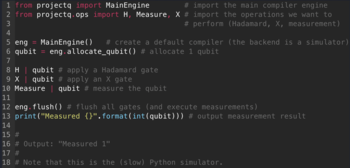Quantum software development kits
Quantum software development kits provide collections of tools to create and manipulate quantum programs. [11] They also provide the means to simulate the quantum programs or prepare them to be run using cloud-based quantum devices and self-hosted quantum devices.
SDKs with access to quantum processors
The following software development kits can be used to run quantum circuits on prototype quantum devices, as well as on simulators.
Perceval
An open-source project created by Quandela for designing photonic quantum circuits and developing quantum algorithms, based on Python. Simulations are run either on the user's own computer or on the cloud. Perceval is also used to connect to Quandela's cloud-based photonic quantum processor. [12] [13]
Ocean
An Open Source suite of tools developed by D-Wave. Written mostly in the Python programming language, it enables users to formulate problems in Ising Model and Quadratic Unconstrained Binary Optimization formats (QUBO). Results can be obtained by submitting to an online quantum computer in Leap, D-Wave's real-time Quantum Application Environment, customer-owned machines, or classical samplers.[ citation needed ]

ProjectQ
An Open Source project developed at the Institute for Theoretical Physics at ETH, which uses the Python programming language to create and manipulate quantum circuits. [14] Results are obtained either using a simulator, or by sending jobs to IBM quantum devices.
Qrisp
Qrisp [15] is an Open Source project coordinated by the Eclipse Foundation [16] and developed in Python programming by Fraunhofer FOKUS [17] Qrisp is a high-level programming language for creating and compiling quantum algorithms. Its structured programming model enables scalable development and maintenance. The expressive syntax is based on variables instead of qubits, with the QuantumVariable as core class, and functions instead of gates. Additional tools, such as a performant simulator and automatic uncomputation, complement the extensive framework. Furthermore, it is platform independent, since it offers alternative compilation of elementary functions down to the circuit level, based on device-specific gate sets.
Qiskit
An Open Source project developed by IBM. [18] Quantum circuits are created and manipulated using Python. Results are obtained either using simulators that run on the user's own device, simulators provided by IBM or prototype quantum devices provided by IBM. As well as the ability to create programs using basic quantum operations, higher level tools for algorithms and benchmarking are available within specialized packages. [19] Qiskit is based on the OpenQASM standard for representing quantum circuits. It also supports pulse level control of quantum systems via QiskitPulse standard. [20]
Qibo
An open source full-stack API for quantum simulation, quantum hardware control and calibration developed by multiple research laboratories, including QRC, CQT and INFN. Qibo is a modular framework which includes multiple backends for quantum simulation and hardware control. [21] [22] This project aims at providing a platform agnostic quantum hardware control framework with drivers for multiple instruments [23] and tools for quantum calibration, characterization and validation. [24] This framework focuses on self-hosted quantum devices by simplifying the software development required in labs.
Forest
An open source project developed by Rigetti, which uses the Python programming language to create and manipulate quantum circuits. Results are obtained either using simulators or prototype quantum devices provided by Rigetti. As well as the ability to create programs using basic quantum operations, higher level algorithms are available within the Grove package. [25] Forest is based on the Quil instruction set.
t|ket>
A quantum programming environment and optimizing compiler developed by Cambridge Quantum Computing that targets simulators and several quantum hardware back-ends, released in December 2018. [26]
Strawberry Fields
An open-source Python library developed by Xanadu Quantum Technologies for designing, simulating, and optimizing continuous variable (CV) quantum optical circuits. [27] [28] Three simulators are provided - one in the Fock basis, one using the Gaussian formulation of quantum optics, [29] and one using the TensorFlow machine learning library. Strawberry Fields is also the library for executing programs on Xanadu's quantum photonic hardware. [30] [31]
PennyLane
An open-source Python library developed by Xanadu Quantum Technologies for differentiable programming of quantum computers. [32] [33] [34] [35] PennyLane provides users the ability to create models using TensorFlow, NumPy, or PyTorch, and connect them with quantum computer backends available from IBMQ, Google Quantum, Rigetti, Quantinuum [36] and Alpine Quantum Technologies. [37] [38]
Quantum Development Kit
A project developed by Microsoft [39] as part of the .NET Framework. Quantum programs can be written and run within Visual Studio and VSCode using the quantum programming language Q#. Programs developed in the QDK can be run on Microsoft's Azure Quantum, [40] and run on quantum computers from Quantinuum, [36] IonQ, and Pasqal. [41]
Cirq
An Open Source project developed by Google, which uses the Python programming language to create and manipulate quantum circuits. Programs written in Cirq can be run on IonQ, Pasqal, [41] Rigetti, and Alpine Quantum Technologies. [37]




